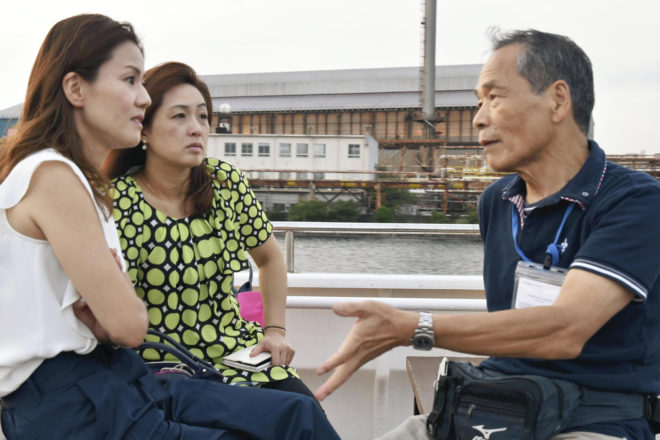
Factories lit up by white and orange lights emerge out of the gathering dusk. As metallic sounds resonate and water vapour blows upward, unusual structures rarely seen in a city stand out.
“That’s a flexicoker, a machine to press heavy oil,” says a tour guide on a sightseeing ship. As he points his finger in the direction of the machine, passengers turn their smartphone cameras toward it.
Evening factory cruises present close-up views of industrial facilities from a waterway running through the Kawasaki waterfront area. One day in mid-September, about 200 people joined a tour.
“The view has a vibrant energy different from the night view of a town. I can feel the vitality of the people working,” said a housewife from Yokohama.
“The lights reflected off the factories are so beautiful,” a female company employee from Shizuoka Prefecture said. The industrial facilities in the Keihin industrial zone were the heartland of Japan’s rapid economic growth period. Rising smoke from the factories used to be a symbol of Japanese economic development, but as time progressed, Kawasaki was dubbed a “polluted city,” giving it a negative image.
The factory cruise tour is part of efforts to change the negative image of factories by turning them into a tourist resource. The city started industrial tours, including night tours, on a trial basis in 2008, and received a strongly positive response. To fully launch the tours, the city invited applications the next year for a position in charge of planning factory tours for the Kawasaki City Tourist Association. Yasuyuki Kameyama of Suginami Ward, Tokyo, was one of the people who applied for the job.
Kameyama, a former official of All Nippon Airways Co., is at home in the tour business. He was fascinated by the evening view of the factories, and was confident that they would appeal to female customers.
He proposed factory tours to bus and cruise ship firms, and personally searched for attractive spots at factories. Soon after cruise and bus tours started in 2010, the reputation of the tours spread very quickly.
Kameyama, however, was not satisfied. He continued negotiating with factories that have many roped-off areas, and gradually increased the number of facilities that allow a close view. The cruise tours operate along more courses now, offering options that set sail from the Tokyo metropolitan area and Yokohama.
The city now trains volunteer guides who accompany tour participants. Applicants must pass an examination, the Yokoso Kawasaki Kentei, conducted by the city and others. After passing the exam, they receive instruction from former cabin attendants and others.
A volunteer guide provides knowledge about factories — ranging from things like the industrial zone’s history and the names of factories and products to deeper knowledge — tailoring their presentation to the customers’ reactions. The guides are able to explain, for example, that “white lights indicate where the employees are working.”
People involved with the factories sometimes participate in the tours, so the guides must have a high level of knowledge. “The factories of Kawasaki have contributed to the development of the city for a long time. What the passengers learn creates a deep understanding [of the factories,]” said guide Daiji Hasegawa. The tours’ success has boosted the pride of factory workers and encouraged them to work harder, Hasegawa said.
The bus tours departing from Tokyo Station are so popular, they are fully booked a month in advance. Nevertheless, Kameyama is looking further into the future.
“There are so many other things we can do, such as utilizing a smartphone app that shows attractive spots, or introducing tours for foreign passengers ahead of the Tokyo Olympics,” he said. By implementing these various ideas, the city might become a brighter place to visit.
Kawasaki
An ordinance-designated city in northeastern Kanagawa Prefecture. The long, thin city is located between Yokohama and Tokyo. It consists of seven administrative wards, such as Kawasaki Ward, which includes an industrial zone and Nakahara Ward, a popular residential area. Due to its convenient location, with Kawasaki Station about 15 minutes from Haneda Airport and Tokyo Station, the population has continued to rise, exceeding 1.5 million in April. Many sports teams, such as the J.League soccer team Kawasaki Frontale, have a base in Kawasaki. The Fujiko F. Fujio Museum, which displays original drawings of Doraemon, attracts many foreign visitors.